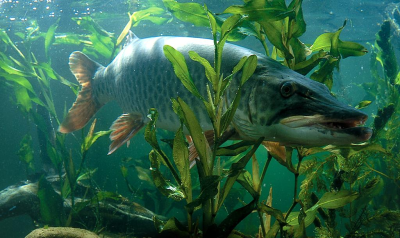 Muskellunge were native to Ohio waters
and were found to be abundant as early as 1810, and were still considered economically
important as a commercial fishery as late as 1930. After 1930, muskellunge populations
declined significantly, particularly in the Lake Erie drainage area, as a result
of urbanization, blocking of migration routes to spawning areas by dams, and from
draining vast marshlands they spawned in for agriculture. Stream populations were
severely limited by pollution, channelization, and siltation of spawning habitat.
This species was hardly known to modern-day anglers until the Ohio Division of Wildlife
began its artificial propagation program in 1952. Muskellunge were native to Ohio waters
and were found to be abundant as early as 1810, and were still considered economically
important as a commercial fishery as late as 1930. After 1930, muskellunge populations
declined significantly, particularly in the Lake Erie drainage area, as a result
of urbanization, blocking of migration routes to spawning areas by dams, and from
draining vast marshlands they spawned in for agriculture. Stream populations were
severely limited by pollution, channelization, and siltation of spawning habitat.
This species was hardly known to modern-day anglers until the Ohio Division of Wildlife
began its artificial propagation program in 1952.
In 1953, 10,000 fry were stocked
in Rocky Fork Lake and 2,265 fingerlings were stocked in nine selected lakes and
streams, inaugurating a new muskie era for Ohio. Since then, the Ohio Division of
Wildlife has greatly expanded its propagation and stocking program. During 1982,
the Division of Wildlife redirected its efforts to the production of 8-inch to 10-inch
fish, because ongoing research demonstrated that they survived better than 3-inch
to 6-inch fish.
 Today, the Ohio Division of
Wildlife Muskellunge program is aimed at producing trophy angling opportunities
through put-grow-take stockings. There are nine Ohio impoundments annually stocked
with advanced fingerlings (9-11 inches) at about 1 fish per acre; Alum Creek, Caesar
Creek Lake, Clear Fork Reservoir, C.J. Brown Reservoir, Lake Milton, Leesville Lake, West Branch Reservoir,
Piedmont Lake, and Salt Fork Lake. Approximately 20,000 muskie averaging 10
inches in length are stocked in Ohio lakes and reservoirs annually. Today, the Ohio Division of
Wildlife Muskellunge program is aimed at producing trophy angling opportunities
through put-grow-take stockings. There are nine Ohio impoundments annually stocked
with advanced fingerlings (9-11 inches) at about 1 fish per acre; Alum Creek, Caesar
Creek Lake, Clear Fork Reservoir, C.J. Brown Reservoir, Lake Milton, Leesville Lake, West Branch Reservoir,
Piedmont Lake, and Salt Fork Lake. Approximately 20,000 muskie averaging 10
inches in length are stocked in Ohio lakes and reservoirs annually.
In selecting lakes for stocking,
emphasis is placed upon keeping a relatively even distribution of lakes throughout
the state so that all Ohioans can enjoy these fisheries. Water quality, habitat,
forage base, and angler access are also important considerations.
 Most Ohio muskies are caught during
April through October when the water temperature is 55 to 75 degrees Fahrenheit.
In addition to the lakes listed above, muskie can also be found in Milton and Pymatuning
Lakes; Berlin Lake has a low density muskie population which is maintained by natural
reproduction. Good muskellunge streams include Paint Creek, Grand River, Sunfish
Creek, Little Muskingum River, Rocky Fork Creek, Salt Creek, Wills Creek, and the
Mahoning River. Ohio has no length limit on muskie, and one muskie per day may be
harvested. Most Ohio muskies are caught during
April through October when the water temperature is 55 to 75 degrees Fahrenheit.
In addition to the lakes listed above, muskie can also be found in Milton and Pymatuning
Lakes; Berlin Lake has a low density muskie population which is maintained by natural
reproduction. Good muskellunge streams include Paint Creek, Grand River, Sunfish
Creek, Little Muskingum River, Rocky Fork Creek, Salt Creek, Wills Creek, and the
Mahoning River. Ohio has no length limit on muskie, and one muskie per day may be
harvested.
In order to obtain needed
information on the annual muskellunge catch and harvest, the Ohio Division of Wildlife
formed the Ohio Huskie Muskie Club (OHMC) during 1961. The club provides the Ohio
Division of Wildlife with statewide information on muskellunge catch and harvest
and also works to foster and promote sport fishing for muskellunge. OHMC has proven
to be an excellent vehicle for obtaining information which is valuable in evaluating
fish management activities and planning for the future. In addition: the State now
supports five active chapters of Muskies, Inc..
Opportunities for catching
muskies are better in Ohio today than ever before: Ohio ranks high among the states
each year in total catch of muskellunge, and for the past several years has been
among the leaders in size taken.
|